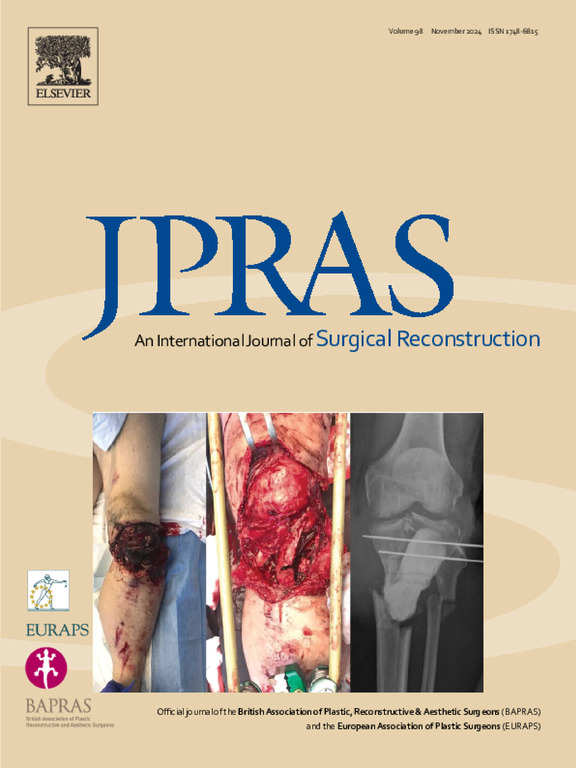在成人手部择期手术中使用无止血带宽醒局部麻醉(WALANT)的患者满意度:系统回顾和荟萃分析。
IF 2
3区 医学
Q2 SURGERY
Journal of Plastic Reconstructive and Aesthetic Surgery
Pub Date : 2024-10-18
DOI:10.1016/j.bjps.2024.10.027
引用次数: 0
摘要
背景:无止血带宽醒局部麻醉(WALANT)在手外科越来越受欢迎。然而,当 WALANT 与使用气动止血带的传统麻醉技术相比时,患者的满意度尚不明确。本研究旨在评估患者对 WALANT 技术的满意度:使用 PubMed、Embase 和 Cochrane 数据库对 2003 年至 2023 年 6 月期间的观察性研究和随机对照试验 (RCT) 进行了文献检索。研究对象为接受手部择期手术的成年人。患者满意度和术后疼痛的手术时间平均差和标准化平均差(SMD)(结果:我们的分析纳入了 5 项研究性临床试验和 15 项观察性研究,共包括 1800 名患者。其中,899 名患者接受了 WALANT 治疗(50.0%)。研究发现,接受 WALANT 治疗的患者满意度更高(SMD 1.01,95% CI 0.11-1.92,P = 0.03,I² = 93%)。使用WALANT后,术后疼痛无显著性差异(95% CI -3.72-0.03,p = 0.10,I² = 99%),手术时间差异也无显著性差异(95% CI -0.42-0.40,p = 0.96,I² = 0%):结论:与使用止血带麻醉相比,在手部择期手术中使用WALANT可能会提高满意度。WALANT的术后疼痛和手术时间也没有劣势,但还需要更多可靠的研究来验证这些发现。本文章由计算机程序翻译,如有差异,请以英文原文为准。
Patient satisfaction using wide-awake local anaesthesia no tourniquet (WALANT) in adults undergoing elective hand surgery: A systematic review and meta-analysis
Background
Wide-awake local anaesthesia no tourniquet (WALANT) is increasing in popularity within hand surgery. However, evidence is unclear on patient satisfaction rates when WALANT is compared against more traditional anaesthetic techniques where pneumatic tourniquets are used. The present study aimed to evaluate the satisfaction rates of patient with the WALANT technique.
Methods
A literature search was performed using the PubMed, Embase and Cochrane databases for observational studies and randomised controlled trials (RCTs) from 2003 up to June 2023. The review was carried out among adults undergoing elective hand surgery. The mean difference in operation time and standardised mean difference (SMD) for patient satisfaction and post-operative pain (<24 h) were computed using the random effects model. The quality of studies was evaluated using RoB-2 for RCTs and risk of bias in non-randomised studies ROBINS-I for observational studies. Data were collated and a meta-analysis was performed.
Results
Five RCTs and 15 observational studies were included in our analysis, comprising a total cohort of 1800 patients. Among them, 899 patients received WALANT (50.0%). Among the RCTs, patient satisfaction was found to be higher in patients receiving WALANT (SMD 1.01, 95% CI 0.11–1.92, p = 0.03, I² = 93%). Post-operative pain was found to be non-significant using WALANT (95% CI −3.72–0.03, p = 0.10, I² = 99%), as was operative time difference (95% CI −0.42–0.40, p = 0.96, I² = 0%).
Conclusion
The use of WALANT in elective hand surgery potentially results in higher satisfaction rates compared with anaesthesia with tourniquets. Post-operative pain and operation time were also found to be non-inferior in WALANT, but more robust studies are needed to verify these findings.
求助全文
通过发布文献求助,成功后即可免费获取论文全文。
去求助
来源期刊
CiteScore
3.10
自引率
11.10%
发文量
578
审稿时长
3.5 months
期刊介绍:
JPRAS An International Journal of Surgical Reconstruction is one of the world''s leading international journals, covering all the reconstructive and aesthetic aspects of plastic surgery.
The journal presents the latest surgical procedures with audit and outcome studies of new and established techniques in plastic surgery including: cleft lip and palate and other heads and neck surgery, hand surgery, lower limb trauma, burns, skin cancer, breast surgery and aesthetic surgery.

 求助内容:
求助内容: 应助结果提醒方式:
应助结果提醒方式:


